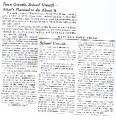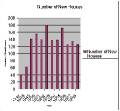| |
The Baby Boom Explodes: Demographics of Wayland
Local Historians: Adam Rich & Isaac Aaron
Throughout the 1950's, Wayland was a town similar to many others in the area. While the
1950's were generally conservative times, they were not static in all respects, as the town experienced ten years of record growth and development during the decade. As the
1940's drew to a close, the stage was set for a boom in demographic and economic growth. The
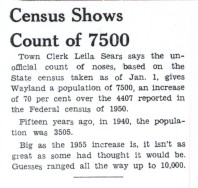 return of World War II Veterans in 1945 fueled a vast population explosion known as the
"Baby Boom." Today, the advent of the Baby Boomer generation is regarded as one of the most quintessential
1950's themes. In Wayland the population more than doubled within these ten years.
As Wayland developed throughout the 1940's, the town could not possibly imagine the change that would come about in the next few years. The incredible population growth from 4,400 people in 1950 to 10,200 people in 1960, meant that a tremendous expansion of houses and
schools would have to occur. return of World War II Veterans in 1945 fueled a vast population explosion known as the
"Baby Boom." Today, the advent of the Baby Boomer generation is regarded as one of the most quintessential
1950's themes. In Wayland the population more than doubled within these ten years.
As Wayland developed throughout the 1940's, the town could not possibly imagine the change that would come about in the next few years. The incredible population growth from 4,400 people in 1950 to 10,200 people in 1960, meant that a tremendous expansion of houses and
schools would have to occur.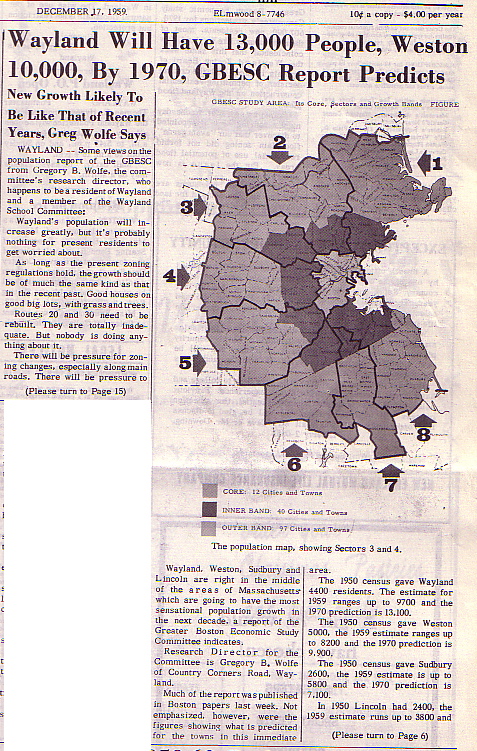
The Boomers would later break traditions in many ways--they were labeled, for example, as the rock and roll generation and the 'now' generation. New cultural trends began to take over, such as rock and roll, which challenged the once dominating themes of conformity and
and conservatism. Due to the  increasing birth and growth rates, there was the expansion of new houses and skyrocketing school enrollment numbers.
For example, in contrast with the 40 new homes built in 1948, 181 were constructed in 1953. The number of students enrolled in grades 1-12 more than doubled from 1950 and a total of 947 students to 1959 with a total of 2,193.
This increase in the number of students led to more then just bigger class sizes, as the citizens were forced to construct three new Wayland schools beginning in 1955. These
schools would remain intact for years to come, a constant reminder of the old generation and the fertile times of the 1950's! increasing birth and growth rates, there was the expansion of new houses and skyrocketing school enrollment numbers.
For example, in contrast with the 40 new homes built in 1948, 181 were constructed in 1953. The number of students enrolled in grades 1-12 more than doubled from 1950 and a total of 947 students to 1959 with a total of 2,193.
This increase in the number of students led to more then just bigger class sizes, as the citizens were forced to construct three new Wayland schools beginning in 1955. These
schools would remain intact for years to come, a constant reminder of the old generation and the fertile times of the 1950's!
Wayland's character as a suburb of Boston located along the new 128 beltway meant that the number of every-day commuters increased steadily. While large numbers of residents found stable and well-paying jobs at the new Raytheon plant, every morning approximately 2,000
Wayland commuters would set off for 72 nearby towns and cities (League of Women Voters survey and report, 1960). This was yet another representation of
Wayland's small town personality as an emerging "bedroom community." Even though these 2,000 workers had to leave the town to work elsewhere, Wayland was attractive because of its "small town" educational system and its overall flavor as a great place to raise a family in the 1950's. Wayland was and continues to be a town overwhelmingly influenced by the baby boom generation. In every way it appears that our small northern town is highly representative of the national demographic trends of the era.
Wayland Town Reports
Reports of the Building Inspector
1948
26 alterations
40 new houses
1 filling station
1 supervising building
1 club house
1 horse barn
1 hen house
1 silo
1 corn crib
1 storage shed
1 pumping station
|
1949
31 alterations
63 new houses
13 garages
1 lubritorium
1 green house
1 studio
1 dairy barn
1 shed
|
1950
19 alterations
141 new houses
7 garages
1 shed
1 filling station
1 post office
1 commissary
1 boiler room
1 store
2 hen houses
|
1951
31 alterations
155 new houses
1 hen house
1 guest house
10 garages
1 silo
|
1952
31 alterations
140 new houses
14 garages
4 storage sheds
1 tool shed
1 fire station
|
1953
36 alterations
181 new houses
2 green houses
12 garages
3 storage sheds
1 car port
1 commercial building
1 telephone exchange
1 clinic
1 school
|
1954
39 alterations
137 new houses
3 storage sheds
17 garages
1 produce stand
1 porch
1 green house
1 pavilion
1 machine shop
1 research laboratory
|
1955
62 alterations
138 new houses
1 manufacturing plant
23 garages
4 car ports
1 filling station
1 research laboratory
1 guest house
1 public garage
1 stable
1 pumping station
|
1956
48 alterations
172 new houses
15 garages
1 shed
4 stables
3 plant additions
1 patio
5 porches
1 town office and fire station
2 school buildings
2 car ports
1 tower base
|
1957
126 new houses
44 alterations
11 garages
5 porches
1 office building
1 green house
1 test building
1 awning structure
1 plant addition
1 test tower
1 salesroom
1 filling station
1 highway garage
1 wood shed
|
1958
134 new houses
50 alterations
7 garages
5 porches
1 plant addition
1 cow barn
1 tavern
2 storage sheds
1 hen house
1 shopping center
1 tool shed
1 filling station
|
1959
125 new houses
68 alterations
17 garages
2 green houses
1 cow barn
1 patio
2 filling stations
1 church addition
1 new church
1 barn addition
1 breezeway
1 business block
1 high school
1 car port
1 hen house
1 tool shed
1 dumb waiter
1 rectory
1 shipping room
1 stable
1 porch
1 kennel
1 building to be torn down
|
Total Number of Students in Grades 1-12 1950-1960 (Town Reports)
1950-1951: 947
1951-1952: 1028
1952-1953: 1129
1953-1954: 1231
1954-1955: 1323
1955-1956: 1498
1956-1957: 1621
1957-1958: 1821
1958-1959: 1983
1959-1960: 2193
|
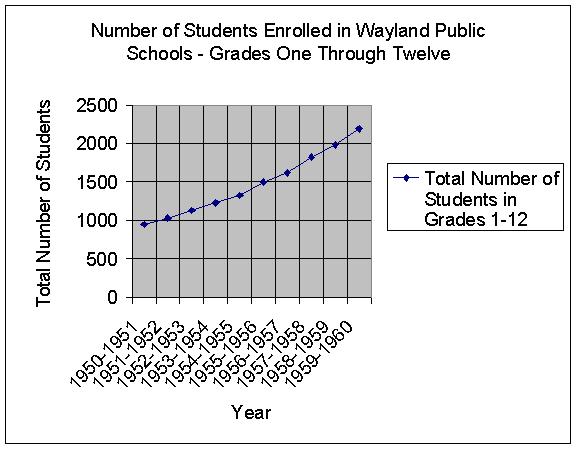
|
Number of New Houses
1948-1959 (Town Reports)
1948: 40
1949: 63
1950: 141
1951: 155
1952: 140
1953: 181
1954: 137
1955: 138
1956: 172
1957: 126
1958: 134
1959: 125
|

|
Please click on the images below to view an enlarged version.
Top of Page
|








